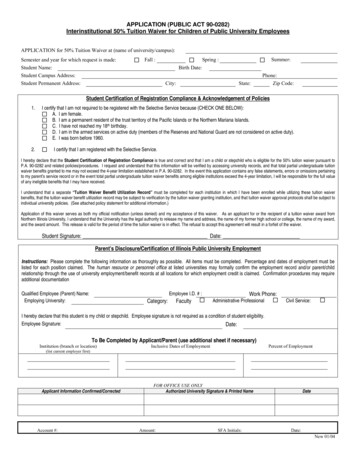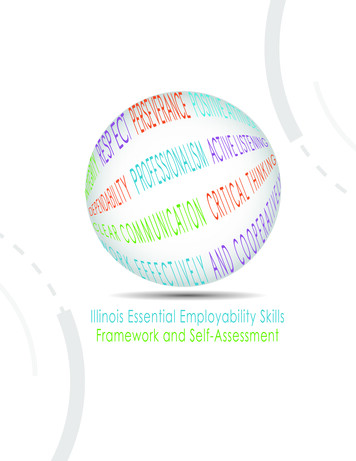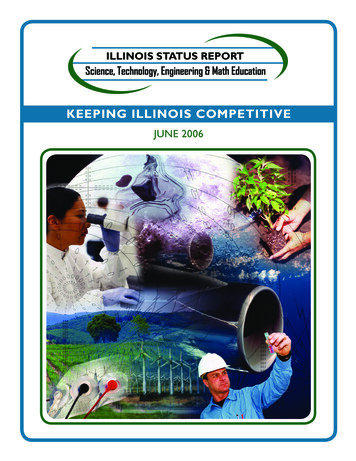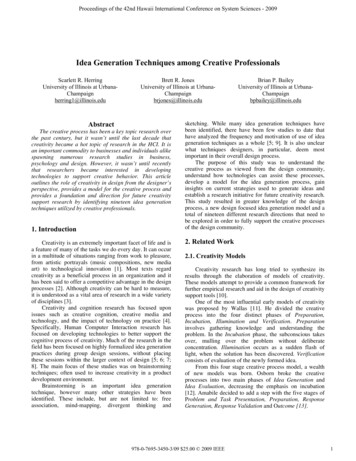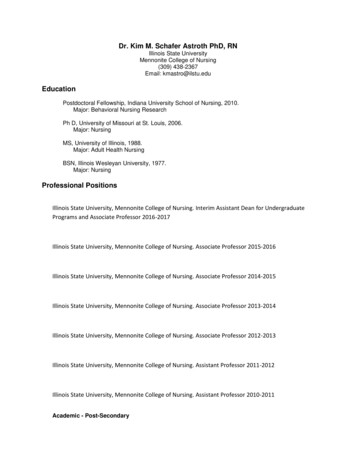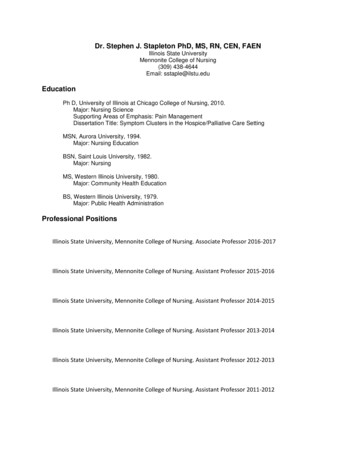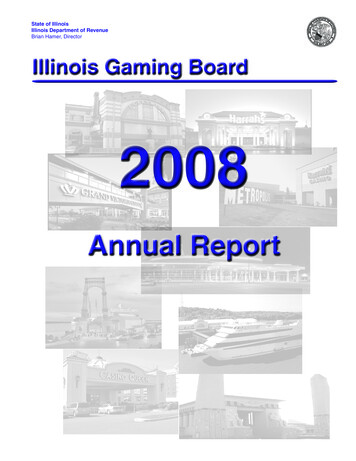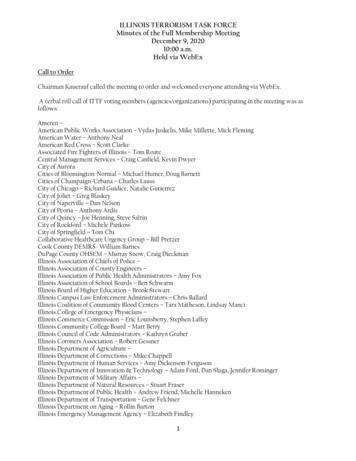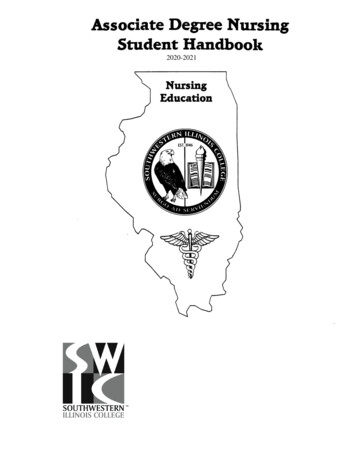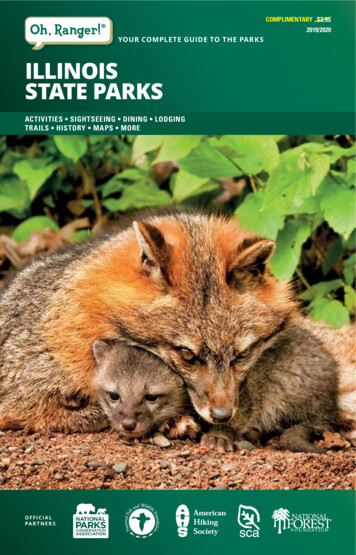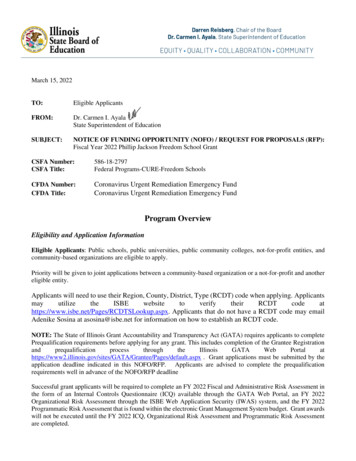
Transcription
March 15, 2022TO:Eligible ApplicantsFROM:Dr. Carmen I. AyalaState Superintendent of EducationSUBJECT:NOTICE OF FUNDING OPPORTUNITY (NOFO) / REQUEST FOR PROPOSALS (RFP):Fiscal Year 2022 Phillip Jackson Freedom School GrantCSFA Number:CSFA Title:586-18-2797Federal Programs-CURE-Freedom SchoolsCFDA Number:CFDA Title:Coronavirus Urgent Remediation Emergency FundCoronavirus Urgent Remediation Emergency FundProgram OverviewEligibility and Application InformationEligible Applicants: Public schools, public universities, public community colleges, not-for-profit entities, andcommunity-based organizations are eligible to apply.Priority will be given to joint applications between a community-based organization or a not-for-profit and anothereligible entity.Applicants will need to use their Region, County, District, Type (RCDT) code when applying. . Applicants that do not have a RCDT code may emailAdenike Sosina at asosina@isbe.net for information on how to establish an RCDT code.NOTE: The State of Illinois Grant Accountability and Transparency Act (GATA) requires applicants to completePrequalification requirements before applying for any grant. This includes completion of the Grantee es/GATA/Grantee/Pages/default.aspx . Grant applications must be submitted by theapplication deadline indicated in this NOFO/RFP. Applicants are advised to complete the prequalificationrequirements well in advance of the NOFO/RFP deadlineSuccessful grant applicants will be required to complete an FY 2022 Fiscal and Administrative Risk Assessment inthe form of an Internal Controls Questionnaire (ICQ) available through the GATA Web Portal, an FY 2022Organizational Risk Assessment through the ISBE Web Application Security (IWAS) system, and the FY 2022Programmatic Risk Assessment that is found within the electronic Grant Management System budget. Grant awardswill not be executed until the FY 2022 ICQ, Organizational Risk Assessment and Programmatic Risk Assessmentare completed.
Dun and Bradstreet Universal Numbering System (DUNS) Number and System for Award Management(SAM): Each applicant (unless the applicant is an individual or federal or state awarding agency that is exemptfrom those requirements under 2 CFR § 25.110(b) or (c), or has an exception approved by the federal or stateawarding agency under 2 CFR § 25.110(d)) is required to:(i) Be registered in SAM before submitting its application. If you are not registered in SAM, you maydo so at www.sam.gov;(ii) Provide a valid DUNS number in its application; and(iii) Continue to maintain an active SAM registration with current information at all times during whichit has an active federal, federal pass-through or state award or an application or plan underconsideration by a federal or state awarding agency. The Illinois State Board of Education (ISBE)may not consider an application for a federal pass-through or state award to an applicant until theapplicant has complied with all applicable DUNS and SAM requirements.: Guidance is found at /pdf/CFR-2013-title2-vol1.pdfThis grant is subject to the provisions of: ID 3559&ChapterID 7 07000sections.html.Merit-Based Review and Selection Process for Competitive Grants: ISBE is required to design and execute amerit-based review and selection process for applications. This process is incorporated by reference in all applicablefunding opportunities. Applicants are advised to refer to the ISBE Merit-Based Review Policy., which can be foundat https://www.isbe.net/Documents/Merit Based Review Policy.pdf.Grant Award/Cost Sharing or Matching: The total amount of federal funding available is 17 million. Theamount funded per applicant will be 350,000. A cost sharing or matching component is acceptable but not requiredfor these funds.Grant Period: The grant period will begin no sooner than May 9, 2022 and will extend from the execution date ofthe grant until August 31, 2023. Successful applicants may reapply via continuing application for up to twoadditional year (s). Funding in the subsequent years will be contingent upon compliance with federal and state law,state grant-making rules, passage of sufficient appropriations for the program, and satisfactory performance in thepreceding grant period. No promise or undertaking made in this NOFO/RFP is an assurance that a grant agreementwill be renewed, nor does this NOFO/RFP create any right to or expectation of renewal.Submission Dates and Times/Other Submission Requirements: Proposals can be submittedelectronically through the ISBE Attachment Manager or mailed no later than 4:30 p.m. May 6, 2022.Directions for each submission method are found below.Electronic Submission: Completed proposals submitted electronically should be scanned into one PDF with allsupporting documents and required signatures.The ISBE Attachment Manager is found athttps://sec1.isbe.net/attachmgr/default.aspx. Choose Sosina, Adenike from the drop-down menu in ReceiverInformation. Submit the application using the button at the bottom of the page.Mailed Proposals: Mail the original and an electronic copy of the proposal on a USB flash drive to Adenike Sosina,Wellness Department, 100 N. First Street, E-222, Springfield, IL, 62777 to ensure the NOFO/RFP response is inthe ISBE offices no later than 4:30 p.m. May 6, 2022. It is advised to use certified mail with guaranteed deliverydate and a return receipt requested.Late proposals will not be accepted.-2-
Grant Award Notice: It is anticipated that successful applicants will receive a Notice of Award via emailapproximately 90 days after the application deadline. The award letter is NOT an authorization to begin performanceor expenditures. After the merit-based appeal timeframe has ended, awardees will receive additional informationfrom the program area that includes the next steps for finalizing the grant. Monies spent prior to programmaticapproval are done so at the applicant’s own risk.Technical Assistance Session: A technical assistance session will be held at 1 pm on March 17, 2022. Registrationinformation is found here. Attendance is not required.Changes to NOFO/RFP: ISBE will post any changes made to the NOFO/RFP prior to April 22, 2022, .aspx. Applicants are advised to check the site before submittinga proposal.Agency Contact: For more information on this NOFO/RFP, contact Adenike Sosina at (217) 782-5270 orasosina@isbe.net. All questions asked concerning this NOFO/RFP will be responded to in a Frequently AskedQuestions document found here so all respondents can see all questions and the responses to the questions. Changesto the FAQ will not be made after April 22, 2022. Applicants are advised to check the site before submitting aproposal.-3-
General InformationProgram Background and DescriptionProgram Purpose:The purpose of this funding opportunity is to establish a Freedom School network to supplement the learning takingplace in public schools by creating programs with a mission to improve the odds for children in poverty.Freedom Schools in multiple states use a research-based and multicultural curriculum for disenfranchisedcommunities most affected by the opportunity gap and learning loss caused by the pandemic, and by expanding theteaching of African American history, developing leadership skills, and providing an understanding of the tenets ofthe civil rights movement.Program Description:Freedom School programs will operate at least a six-week summer program and/or a program during the schoolyear that provides out-of-school learning opportunities that may include before-school, after-school, or weekendprogramming. The mission of the program is to improve the odds for children living in poverty. Programs mustuse a research-based and multicultural curriculum for disenfranchised communities most affected by the opportunitygap and learning loss caused by the pandemic, and by expanding the teaching of African American history,developing leadership skills, and providing an understanding of the tenets of the civil rights movement.The teachers in Freedom Schools must be from the local community, with an emphasis on historically disadvantagedyouth, including African American students and other students of color, so that (i) these individuals have access tosummer jobs and teaching experiences that serve as a long-term pipeline to educational careers and the hiring ofminority educators in public schools, (ii) these individuals are elevated as content experts and community leaders,and (iii) Freedom School students have access to both mentorship and equitable educational resources.Program Background/History:The fundamental goal of the Freedom Schools of the 1960s was to provide quality education for all students, tomotivate active civic engagement, and to empower disenfranchised communities. The renowned and progressivecurriculum of Freedom Schools allowed students of all ages to experience a new and liberating form of educationthat directly related to the imperatives of their lives, their communities, and the Freedom Movement.Freedom Schools continue to demonstrate the proven benefits of critical civic engagement and intergenerationaleffects by providing historically disadvantaged students, including African American students and other studentsof color, with quality instruction that fosters student confidence, critical thinking, and social and emotionaldevelopment.Freedom Schools offer culturally relevant learning opportunities with the academic and social supports that Blackchildren need by utilizing quality teaching, challenging, and engaging curricula, wrap-around supports, a positiveschool climate, and strong ties to family and community. Freedom Schools have a clear focus on results.Program Objectives:Programs must provide intentionally and imaginatively employ strategies that focus on all the following:Civic engagementLiteracyRacial justice and equity.Transparency and building trusting relationshipsSelf-determination and governanceBuilding on community strengths and community wisdomUtilizing current data, best practices, and evidenceShared leadership and collaboration-4-
A reflective learning cultureA whole child approach to educationPrograms should provide for engaging, culturally relevant, and challenging curricula; high-quality teaching; wraparound supports and opportunities; positive discipline practices, such as restorative justice; and leadershipopportunities.Programs must strive for authentic parent and community engagement during the development of Freedom Schoolsand their curriculum. Authentic parent and community engagement include all the following: A shared responsibility that values equal partnerships between families and professionals.Ensuring that students and families who are directly impacted by Freedom School policies and practicesare the decision-makers in the creation, design, implementation, and assessment of those policies andpractices.Genuine respect for the culture and diversity of families.Relationships that center around the goal of supporting family well-being and learning.Students participating in Freedom School programs will be required to participate in pre- and post-assessments ofliteracy and other program objectives.Policy Requirements:There are no State Board of Education policy requirements for this posting.Performance Measures:There will be a 10 percent increase in proficiency and growth in literacy and other program objectives for programparticipants by the end of the program on pre- and post-assessments.There will be a 10 percent increase in parent and community engagement for 20 percent of student participants bythe end of the program.Targets:There will be a 2.5 percent increase in proficiency and growth in literacy and other program objectives for programparticipants by the end of the program on pre- and post-assessments.Parent and community engagement rates will be 2.5 percent higher for student participants.Performance Standards:There will be a 5 percent increase in proficiency and growth in literacy and other program objectives for programparticipants by the end of the program on pre- and post-assessments in literacy.There will be 5 percent annual higher parent and community engagement rates for student participants.Deliverables and Milestones:Deliverable 1: Attendance at ISBE-sponsored workshops and trainings.Deliverable 2: Completion of annual Grant Periodic Performance Report via IWAS.Deliverable 3: Administration of pre- and post-assessments to program participants.-5-
Program SpecificationsFreedom Schools provide activities and support using a research-based and multicultural curriculum fordisenfranchised communities most affected by the opportunity gap and learning loss caused by the COVID-19pandemic, and by expanding the teaching of African American history, developing leadership skills, and providingan understanding of the tenets of the civil rights movement.Funding InformationIntroduction:All grant funds disbursed to administer the Freedom Schools program and all related services must be handled inaccordance with the authorizing legislation (105 ILCS 5/2-3.186); the State and Federal Grant AdministrationPolicy, Fiscal Requirements, and Procedures handbook; and 23 Illinois Administrative Code 100 (Requirementsfor Accounting, Budgeting, Financial Reporting, and Auditing).Cost Sharing or Matching:A cost sharing or matching component is acceptable but not required for these funds.Indirect Cost Rate:The federal Uniform Guidance at 2 CFR 200 requires that grantees be provided the opportunity to seek indirect costreimbursements based on negotiated indirect cost reimbursement rates. Rates are determined and applied as follows.Local Education Agencies Local Education Agency (LEA) indirect cost rates are developed in accordance with a delegation ofauthority agreement between ISBE and the U. S. Department of Education (ED). The plan includes both arestricted and unrestricted rate for each individual LEA. Both the restricted and unrestricted LEA rates arepublished annually on the ISBE website. The FY22 rates are available an.aspx. In the past, only the restricted rate was allowedwhen budgeting indirect cost reimbursements.LEAs have the ability to seek indirect cost reimbursement at the published unrestricted rate for any programother than those identified as restricted by ED. Newly organized LEAs, Regional Offices of Education, Intermediate Service Centers, area vocationalcenters, charter schools, university laboratory schools, and governmental entities formed by a jointagreement among LEAs utilize either the statewide average of LEA unrestricted or restricted indirect ratesas appropriate, depending on program. LEAs that jointly administer federal program(s) utilize either the approved unrestricted or restrictedindirect cost rates for the administrative district of the joint program as appropriate, depending on program.Non-LEAs Programs eligible for an unrestricted indirect cost rate; not-for-profit entities; community-/faith-basedorganizations; and other non-LEA, non-university subgrantees utilize rates negotiated through theGovernor’s Office of Management and Budget centralized process where they will have the option to:oSelect the 10% diminimus rate.oSubmit documentation supporting a rate determined through negotiation with their federalcognizant agency.oNegotiate a rate.-6-
Non-LEA, non-university grantees may initiate the unrestricted indirect cost rate negotiation processthrough the GATA grantee portal at: https://grants.illinois.gov/portal/. Federal programs requiring the use of a restricted indirect cost rate, not-for-profit entities, community/faith-based organizations, and other non-LEA subgrantees shall utilize the 8% default rate described at 34CFR 76.564. Colleges and Universities will be limited to a maximum indirect cost rate of 8% or other indirect costrate calculated by their cognizant federal agency, whichever is less, for grants administered by ISBE.Costs associated with Fiscal Support Services (2520), Internal Support Services (2570), Staff Support Services(2640), Data Processing Services (2660), and Direction of Business Support Services (2510) charged to theEducational Fund are properly budgeted as indirect costs.Stevens Amendment:For purposes of compliance with Section 511 of P.L. 101-166 (the “Stevens Amendment”), applicants are advisedthat 100 percent of the funds for this program are derived from federal sources. The total amount of federal fundinginvolved is 17 million.Reporting RequirementsPeriodic financial reporting should be completed at a minimum of quarterly via the IWAS system.Programmatic reporting should be completed at a minimum of annually via the IWAS system.Content and Form of Application SubmissionInstructions: Each application must be submitted in the format outlined below to be considered complete. Acomplete application will include all required components (the numbered items below) and signatures whenmentioned. Applications that do not have all the required documents will not proceed in the competition.Please use the checkboxes in front of the numbers as a checklist when assembling your completed application. Itis advised to attach a copy of the completed checklist with the application. 1.Uniform Application for State Grant Assistance (Attachment 1): Include the name, address, andtelephone and fax numbers of the entity; email, name, and telephone number of the contact person; FederalEmployer Identification number; DUNS number; SAM CAGE Code; and all other listed information. TheApplication page must be signed by an official authorized to submit proposals. 2.Program Summary (Attachment 2): Include the proposed number of students to be served, anticipatednumber of teachers, and summary of strategy to recruit and retain teachers and students. Describe howteachers will have access to summer jobs and teaching experiences that serve as a long-term pipeline toeducational careers. 3.Proposal Abstract (Attachment 3): Include information on program activities, organizational capacity,and ability to implement a Freedom Schools program. 4.Program Narrative (Attachments 4A-4D) maximum 4 pages per attachment: Follow the specificationsfound under Program Narrative Requirements below.Objectives and Activities (Attachment 5) maximum 5 pages: Use the form provided to list the objectivesand activities of the proposed project in a time-specific format. Applicant should address all the objectivesthat are listed in this NOFO/RFP on pages 4-5. 5.-7-
6.Proposal Evaluation Design (Attachment 6) maximum 2 pages: Use the form provided to complete theevaluation design. 7.Federal Budget Summary (Attachment 7): The budget MUST be submitted on this form. No otherbudget form will be accepted. District budgets MUST be signed by the district superintendent. Otherapplicants should have an authorized official sign the form. 8.Budget Summary Breakdown (Attachment 7A): The Budget Summary Breakdown MUST includedescriptions of the anticipated expenditures, correlated to the line items set forth on the Federal BudgetSummary. The Budget Summary Breakdown should also include subcontract information, if applicable.The Budget Narrative (Attachment 7B) should describe how funds will be used to support direct instructionto students and program objectives.Program Narrative RequirementsNeedSummarize the needs by describing the process used with the community to determine the need for the project, theavailability of resources for the project, and the data used to determine the need (e.g., student achievement data,demographic data, student behavioral data, and parent data).Describe how the proposed program and services will address the needs of the community, the students, and thefamilies in a culturally, competently, and developmentally appropriate manner to improve the academicperformance of the students.Describe the partnership between the applicant and the community. Describe the relevance and the commitment ofeach collaborative partner in the proposed program to the implementation and success of the project. The descriptionshould support the historical performance of each partner and its capacity to implement the services as described.Describe how the Freedom Schools will enhance current services provided in the community and not duplicateservices currently provided.Program DesignProvide a program schedule of operation including a sample schedule for one week. If programs are offered at morethan one site, include information for each site and the range of programming at each site. Include a rationale forthe proposed hours of operation.Based on the hours of operation, provide details of how the program objectives will be met.Describe in detail how the activities are expected to improve student academic achievement as well as overallstudent success.Describe in detail how the proposed activities are research-based and provide a multicultural curriculum fordisenfranchised communities by expanding the teaching of African American history, developing leadership skills,and providing an understanding of the tenets of the civil rights movement.Provide details on how students will have access to equitable educational resources.InstructionDetail how teachers in Freedom Schools will be recruited and retained.-8-
Explain how teachers in your Freedom Schools program will have access to summer jobs and teaching experiencesthat serve as a long-term pipeline to educational careers.Describe how teachers will be trained to provide curriculum that is engaging, culturally relevant, and challenging.Provide details on how restorative justice practices will be instituted.Community ConnectionsProvide a detailed plan of civic engagement activities that will occur during the program.The applicant must explain how their proposal will engage parents and families with their student and community.Detail how students will have access to mentoring.A detailed plan that centers around the goal of supporting family well-being and children’s development learning.Review CriteriaApplication Review and Selection ProcessThe selection of the grantees will be based upon the overall quality of the application. The scoring is based uponthe following criteria: Need is defined as the identification of stakeholders, facts, and evidence that demonstrate the proposalsupports the grant program purpose. Quality is defined as the totality of features and characteristics of a service, project, or product that indicatesits ability to satisfy the requirements of the grant program. Evaluation is defined as the ability to judge or determine the significance, worth, or quality of a service,project, or product. Capacity is defined as the ability of an entity to execute the grant project according to the projectrequirements.Twenty priority points will be given to joint applications between a community-based organization or a not-forprofit and another eligible entity.Evaluation CriteriaThese overall criteria are built into the rubric on the next page. The attachment number in the parentheses followingthe criteria lists the portion of the proposal that will be used to determine if the criteria has been met. The points foreach section as well as the individual criteria are also included in the rubric.Following the notification of grant awards, an applicant may request copies of reviewer scores and comments bycontacting Adenike Sosina at asosina@isbe.net.-9-
Selection criteria and point values are as follows:Not Provided0Proposalrequirementsare absent.Very Limited1The proposalprovides veryfew details tomeet the projectoutcomes.SomewhatLimited2The proposal isunclear andlacks enoughevidence tomeet projectoutcomes.ModerateStrongVery Strong3Proposalprovidesmoderate detailand conveyspotential to meetprojectoutcomes.4Proposalprovides gooddetail andstrong evidenceto meet projectoutcomes.5Proposal exceedsexpectations andprovides a solidplan to meetprojectoutcomes.Section 1:Need20 PointsPossiblePointsApplicant details the process used with the community to determine the need for the project,the availability of resources for the project, and the data used to determine the need.(Attachment 4A Narrative Need)The proposed program and services will address the needs of the community; the students; andthe families, in a culturally, competently, and developmentally appropriate manner to improvethe academic performance of the students.(Attachment 4A Narrative Need)The partnership between the applicant and the community is relevant. The commitment ofeach collaborative partner is demonstrated in the proposed program. The applicant providesinformation that supports the historical performance of each partner and its capacity toimplement the services as described.(Attachment 4A Narrative Need)Applicant describes how the Freedom Schools will enhance opportunities/services and notduplicate opportunities/services currently available. (Attachment 4A Narrative Need)Section 2:Quality20 Points5555PossiblePointsThe activities are expected to improve student academic achievement as well as overallstudent success.(Attachment 4B Narrative Program Design)The proposed activities are research-based and provide a multicultural curriculum fordisenfranchised communities, expand the teaching of African American history, developleadership skills, and provide an understanding of the tenets of the civil rights movement(Attachment 4B Narrative Program Design)55Applicant provided details on how restorative justice practices will be instituted.(Attachment 4C Narrative Instruction)5The applicant provides details on how students will have access to mentors.(Attachment 4D Narrative Community Connections)5- 10 -
Section 3:Capacity50 PointsPossiblePointsA detailed plan of civic engagement activities that will occur during the program is provided.(Attachment 4D Narrative Community Connections)Detailed information is provided on how teachers in Freedom Schools will be recruited andretained.(Attachment 4C Narrative Instruction)Evidence is provided that teachers will be trained to provide a curriculum that is engaging,culturally relevant, and challenging. (Attachment 4C Narrative Instruction)Applicant explains how teachers in the Freedom Schools program will have access tosummer jobs and teaching experiences that serve as a long-term pipeline to educationalcareers.(Attachment 2 Program Summary)A detailed plan that centers around the goal of supporting family well-being and children’sdevelopment learning is provided.(Attachment 4D Narrative Community Connections)The applicant has provided a plan on how students will be recruited and retained.(Attachment 2 Program Summary)The proposal is practicable, and the proposed activities are likely to contribute to theachievement of program goals and objectives. The proposal includes a realistic timeline, andproposed activities correlate to the proposed budget. Demonstrates the organizationalcapacity to fulfill the requirements of the grant and provide adequate support for theprogram.(Attachment 3 Proposal Abstract)The applicant provides a budget and budget detail that is relevant to the number of studentsserved. The proposed budget is focused on direct services to students.(Attachment 7 Federal Budget Summary, Attachment 7A Budget Summary Breakdown)Previous experience and/or capacity demonstrate the ability to provide educational andrelated activities that will complement and enhance the academic performance, achievement,and positive youth development of the students to be served.(Attachment 3 Proposal Abstract)The applicant has the experience and/or capacity to provide wrap around support to studentsand families.(Attachment 3 Proposal Abstract)Section 4:Evaluation10 Points5555555555PossiblePointsThe applicant has a detailed evaluation plan that includes pre and post assessmentadministration.(Attachment 6 Proposal Evaluation Design)Evaluation methods include the use of objective performance measures that are clearlyrelated to the intended outcomes of the project and will produce quantitative and qualitativedata.(Attachment 6 Proposal Evaluation Design)- 11 -55
SUBJECT: NOTICE OF FUNDING OPPORTUNITY (NOFO) / REQUEST FOR PROPOSALS (RFP): Fiscal Year 2022 Phillip Jackson Freedom School Grant CSFA Number: 586-18-2797 CSFA Title: Federal . Agency Contact: For more information on this NOFO/RFP, contact Adenike Sosina at (217) 782-5270 or . Relationships that center around the goal of supporting .
